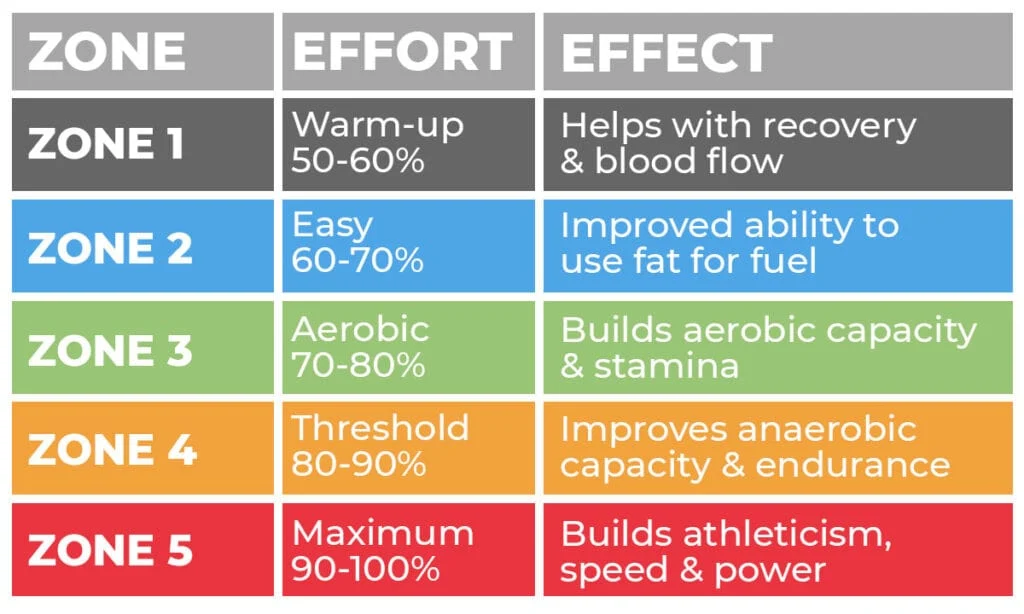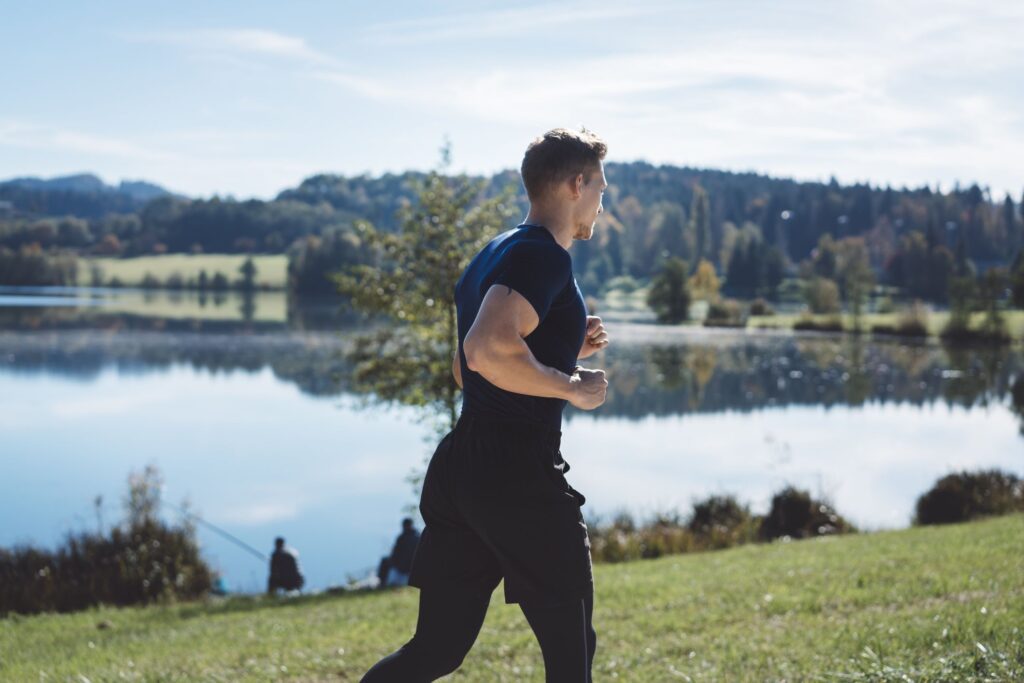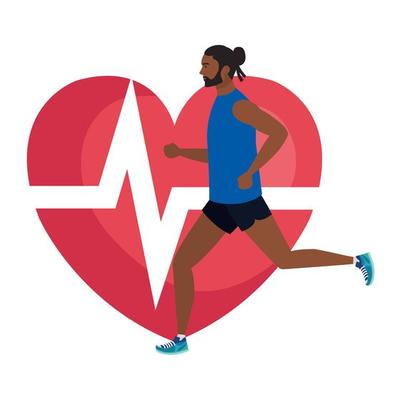Zone 2 cardio training is a foundational endurance-building approach used by athletes, fitness enthusiasts, and even those focused on metabolic health or weight loss. Zone 2 training targets a specific heart rate range that develops the aerobic energy system by maximizing fat oxidation and improving metabolic flexibility. It’s often called “conversational cardio” due to its moderate intensity.
Zone 2 training is one of the five heart rate zones used to define the intensity of activity, zone 1 being easy (e.g. walking or carrying groceries), and zone 5 being the absolute max you can push to. Zone 2 falls into the lower end of the scale, performed at 60-70% of your max heart rate – it’s slow, it’s steady, but it’s still work
What is Zone 2 Cardio?
Zone 2 cardio refers to aerobic exercise performed at a low to moderate intensity, where your body primarily uses fat for fuel rather than carbohydrates.

➤ Physiological Basis:
- Energy Source: Mostly fat oxidation, minimal lactate accumulation.
- Mitochondrial function: Enhances efficiency and density.
- Heart Rate Zone: ~60–70% of your maximum heart rate (HRmax).
- Lactate Threshold: Below the first lactate threshold (LT1) — usually ~1.5 mmol/L lactate.
- Ventilation Marker: Breathing is steady; you can maintain a conversation (“talk test”).

There are five heart rate “zones” which are based on a percentage of your maximum heart rate (MHR).
- Zone 1: warm-up/low effort, such as an easy walk or gentle stretching. In this zone, your heart rate should be between 50-60% of MHR, and you should be able to easily maintain this intensity for an extended period.
- Zone 2: easy effort, such as an incline walk, easy jog or casual bike ride. In Zone 2, your heart rate should be between 60-70% of MHR, and you should be able to maintain this intensity for an extended amount of time, but with more effort than Zone 1.
- Zone 3: moderate effort, such as low-impact strength training, a tempo run or an intense hike. Heart rate should be between 70-80% of MHR, and workouts in this zone should feel hard, but manageable.
- Zone 4: intense effort, such as strength and cardio circuit workouts, tabata workouts and threshold runs. At this zone, your heart rate should be between 80-90% of your MHR, and it should feel challenging to maintain the intensity for longer than 15-20 minutes.
- Zone 5: all-out effort, such as sprints, assault bike sprints, burpees, and high-intensity interval training. This is the most intense zone, and your heart rate should be at 90-100% of your MHR. Because of the intensity, you should only be able to maintain Zone 5 exercises for a few minutes, if that.
As you move between zones, your body starts using different energy sources. In Zones 1 and 2, your body mainly uses fat as fuel. When you’re working in heart rate Zones 3–5, your muscles demand energy faster than your body can deliver oxygen. At this point, your body switches to breaking down carbohydrates (glucose or glycogen) for quick energy through a process called glycolysis. This process produces lactate, which contributes to that burning feeling in your muscles.
BENEFITS OF ZONE 2 TRAINING
Cardiovascular and Metabolic
- Lowers resting heart rate and blood pressure
- Enhances capillary density and oxygen delivery
- Improves blood sugar regulation and insulin sensitivity
Energy and Endurance
- Trains the body to use fat for energy, preserving glycogen
- Delays fatigue onset during endurance activities
- Improves recovery by increasing parasympathetic tone
Cognitive and Mental Health
- Increases BDNF (brain-derived neurotrophic factor)
- Supports mood regulation and reduces stress hormones
Body Composition
- Helps burn fat efficiently during and after training
- Reduces visceral fat (linked to metabolic diseases)

Chronic Conditions Support
- Effective for people with:
- Type 2 Diabetes
- Metabolic syndrome
- Hypertension
- Chronic fatigue syndrome
- Post-COVID syndrome
HOW TO CALCULATE YOUR ZONE 2
Heart Rate Estimation Method
Use this formula: Zone 2 HR=60%−70%×(220−your age)\text{Zone 2 HR} = 60\%-70\% \times (220 – \text{your age})Zone 2 HR=60%−70%×(220−your age)
- Example (Age 40):
- Max HR ≈ 180
- Zone 2 HR Range: 108–126 bpm
More Accurate Method: Use a lab-based VO₂ max test or lactate threshold test.
Lactate Testing
- Stay below 2.0 mmol/L blood lactate
- Ideal range: 1.3–1.8 mmol/L
- Used by elite athletes (e.g., cyclists, triathletes)
Talk Test
- If you can talk in full sentences while training without gasping, you’re likely in Zone 2.
Rate of Perceived Exertion (RPE)
- RPE of 2–4 out of 10
- Feels easy to moderate, sustainable for long durations
1. Less Fatigue, Faster Recovery. 2. Better Performance At Higher Intensities. 3. The Ideal Fat-Burning Zone. 4. An All Round Health-Booster. 5. Improved Mental Health
Structure of a Zone 2 Training Session
| Component | Details |
|---|---|
| Warm-up | 5–10 min at low Zone 1 intensity |
| Main Set | 30–90+ min at Zone 2 intensity |
| Cool-down | 5–10 min Zone 1 again |
| Frequency | 3–6x per week depending on goals and sport |
| Progression | Gradually increase duration or frequency weekly |
Consistency > Intensity: It takes time and volume to build true aerobic fitness.
ZONE 2 MODALITIES
| Mode | Notes |
|---|---|
| Brisk Walking | Good for beginners or joint-sensitive individuals |
| Running | Light jog, but may be too intense for some |
| Cycling | Great for long-duration sessions; easier to stay in Zone 2 |
| Rowing Machine | Full-body, but harder to control intensity |
| Elliptical | Low impact; easy to maintain heart rate zone |
| Swimming | Great for cardiovascular work, harder to measure HR |
SAMPLE WEEKLY ZONE 2 TRAINING PLAN
General Fitness (Beginner/Intermediate)
| Day | Workout |
|---|---|
| Monday | 45 min Zone 2 walk or cycle |
| Tuesday | Strength + 30 min Zone 2 jog |
| Wednesday | Rest or active recovery |
| Thursday | 60 min Zone 2 cardio |
| Friday | 30 min core + 30 min Zone 2 |
| Saturday | Long session (90 min bike/walk) |
| Sunday | Recovery: 30 min walk/stretch |
Endurance Athlete Plan
| Day | Workout |
|---|---|
| Monday | 60 min Zone 2 run |
| Tuesday | Strength + 45 min Zone 2 cycling |
| Wednesday | 90 min Zone 2 with hill intervals (light) |
| Thursday | Rest or light aerobic session (Zone 1) |
| Friday | 60–75 min Zone 2 |
| Saturday | 2–3 hr long ride or run (Zone 2 steady) |
| Sunday | Recovery day: mobility, foam roll, easy walk |
MONITORING TOOLS
| Device | Function |
|---|---|
| Chest Strap HR Monitor | Most accurate for HR tracking |
| Smartwatch (Garmin, Apple, Polar) | Good for HR zone alerts |
| Lactate Meter | Precision for performance athletes |
| Power Meter (Cyclists) | Target 55–75% FTP for Zone 2 |
| Apps (TrainingPeaks, Strava) | Track trends and recovery markers |
COMMON PITFALLS
- Training too hard (creeping into Zone 3 or above)
- Ignoring warm-up or cool-down
- Expecting quick results
- Using wrist HR monitors (inaccurate)
- Thinking “harder = better” (aerobic base needs patience)
Scientific Support
Zone 2 training is supported by:
- Dr. Iñigo San Millán (used with Tour de France cyclists)
- Endurance sports science (running, cycling, rowing)
- Clinical applications (e.g., Type 2 diabetes, metabolic syndrome)
If you like being healthy and fit and the one who loves training so do read this out about strength training


Pingback: Heart health: Detailed description and 10 healthy ways to improve it. - Nutriphyfit